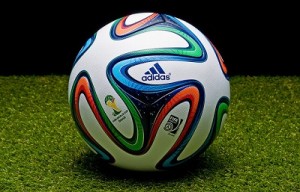The 2014 FIFA World Cup kicks off today in Brazil and the next few weeks will be filled with heart-pounding games that are played by some of the world’s best soccer players.

Although all of the players are integral pieces of the puzzle towards the quest for the coveted FIFA World Cup Trophy, none of these games could be played without the most important piece, the actual soccer ball.
To begin, a standard soccer ball is a sphere that is made of 32 smooth panels, 12 black pentagons and 20 white hexagons. However, this conventional soccer ball design is a thing of the past.
Over the years, Adidas has designed the soccer balls that are used in the World Cup. During the 2010 World Cup in South Africa, Adidas designed the Jabulani ball, which was intended to be aerodynamic in comparison to other soccer balls. However, the players in the tournament begged to differ, saying that the ball was actually “terrible” and that it changed directions mid-flight.
So, for this year’s World Cup, Adidas tweaked their soccer ball invention and created the Brazuca, the official ball of the 2014 World Cup. This soccer ball consists of six textured panels that are shaped like stylized Xs.

In order to perfect this invention, Sungchan Hong and Takeshi Asai, a pair of researchers from the Institute of Health and Sports Science at the University of Tsukuba in Japan, analyzed the aerodynamic properties of the Brazuca ball. Through their research, they put five soccer balls through a series of tests in order to observe their performance.
Their analysis compared the results of wind tunnel tests with actual trajectories through the air. The wind tunnel test results revealed that the Brazuca was the front-runner when it came to the stability of the drag forces, otherwise known as air resistance acting on the ball.
Another set of tests were conducted and each soccer ball was struck 40 times (20 times in each of two orientations) by an “impact-type kick robot” that carried the ball to a goal net 25 meters away. In this test, the Brazuca and a conventional ball were most likely to wind up in the same part of the net after each kick.
Through this battery of tests, the Brazuca soccer ball came out on top.
As previously mentioned, the invention design of the Brazuca includes six panels which distribute the seams differently, creating a smooth flight path. However, the key innovation on this soccer ball is the intentional roughing of the ball’s surface. On the surface, the Brazuca is covered with small polyurethane nubs that imitate the effect that stitches create on a traditional 32-panel ball. These nubs are used to even out turbulence and cut down on what some experts refer to as knuckleballing.
Through all of these design innovations and with the 2014 FIFA World Cup kicking off today, we are anxious to see if the Brazuca soccer ball will score with the players!
Copyright Davison 2014
Sources:
Media:
http://en.wikipedia.org/wiki/2014_FIFA_World_Cup#mediaviewer/File:WC-2014-Brasil.svg